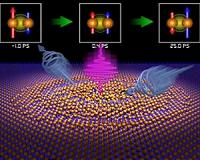 |
London UK (SPX) Apr 18, 2011 Blue denim jeans are one of the most popular and iconic fashion items in the world; now a study published in Biotechnology Journal reveals a cheaper, more efficient and eco-friendly method for treating dyed denim. The process of 'surface activation' used to wash-down the denim following dyeing could also offer an alternative to the dangerous, and internationally banned, sandblasting technique. "The global production of denim is estimated at 3 billion linear meters and more than 4 billion garments per year," said Thomas Bechtold, from the Research Institute for Textile Chemistry and Textile Physics at the University of Innsbruck. "To create blue jeans denim is dyed with indigo an organic compound which is estimated to be produced in quantities of over 30.000 tons per year." Controversially a process of sandblasting is often used for some jeans which are styled with a worn or torn look. The technique is banned in many countries as it can lead to lung disease; however, it is still used in denim workshops in Bangladesh, Egypt, China, Turkey, Brazil and Mexico. Many of the jeans sold in Europe are produced in these countries. Dr Bechtold and his team focused their research on alternative treatment processes, studying the use of chemicals used to bleach the denim. "A central step in the processing of indigo dyed textiles such as blue jeans are the wash and bleach processes used to create a final wash down effect," said Bechtold. "To remove the ring dyed indigo dyestuff manufactures use a combination of drum washing machines and chemical treatments." Oxidising agents are an essential part of this bleach process, with chemicals such as Sodium Hypochlorite (NaOCl) used to reduce the amount of dyestuff. Due to its low cost and the broad amount of bleach effects it can produce NaOCl is currently used in 80% of jean production. Because indigo dyeing is concentrated on the outer layers of fabric Dr Bechtold's team turned to a surface activation technique Because indigo dyeing is concentrated on the outer layers of fabric Dr Bechtold's team turned to a surface activation technique which could lead to a reduction in the amount of chemicals needed to achieve the same effect. . The surface activation technique presents several advantages including preventing the decease of fabric strength, shortening the duration of the wash-down process and reducing the concentrations of costly chemicals. "This method also offers a replacement of the sandblasting of denim, which is an extremely unhealthy process for which, until now, there have been few alternatives available", concluded Bechtold. "The surface activation method also allows for more eco-friendly processing of jeans in the garment industry which is approximately 10% of the total cotton market worldwide."
Share This Article With Planet Earth
Related Links - Space Technology News - Applications and Research
 Ultra-Fast Magnetic Reversal Observed
Ultra-Fast Magnetic Reversal ObservedBerlin, Germany (SPX) Apr 18, 2011 A newly discovered magnetic phenomenon could accelerate data storage by several orders of magnitude. With a constantly growing flood of information, we are being inundated with increasing quantities of data, which we in turn want to process faster than ever. Oddly, the physical limit to the recording speed of magnetic storage media has remained largely unresearched. In experiments performe ... read more |
|
| The content herein, unless otherwise known to be public domain, are Copyright 1995-2010 - SpaceDaily. AFP and UPI Wire Stories are copyright Agence France-Presse and United Press International. ESA Portal Reports are copyright European Space Agency. All NASA sourced material is public domain. Additional copyrights may apply in whole or part to other bona fide parties. Advertising does not imply endorsement,agreement or approval of any opinions, statements or information provided by SpaceDaily on any Web page published or hosted by SpaceDaily. Privacy Statement |